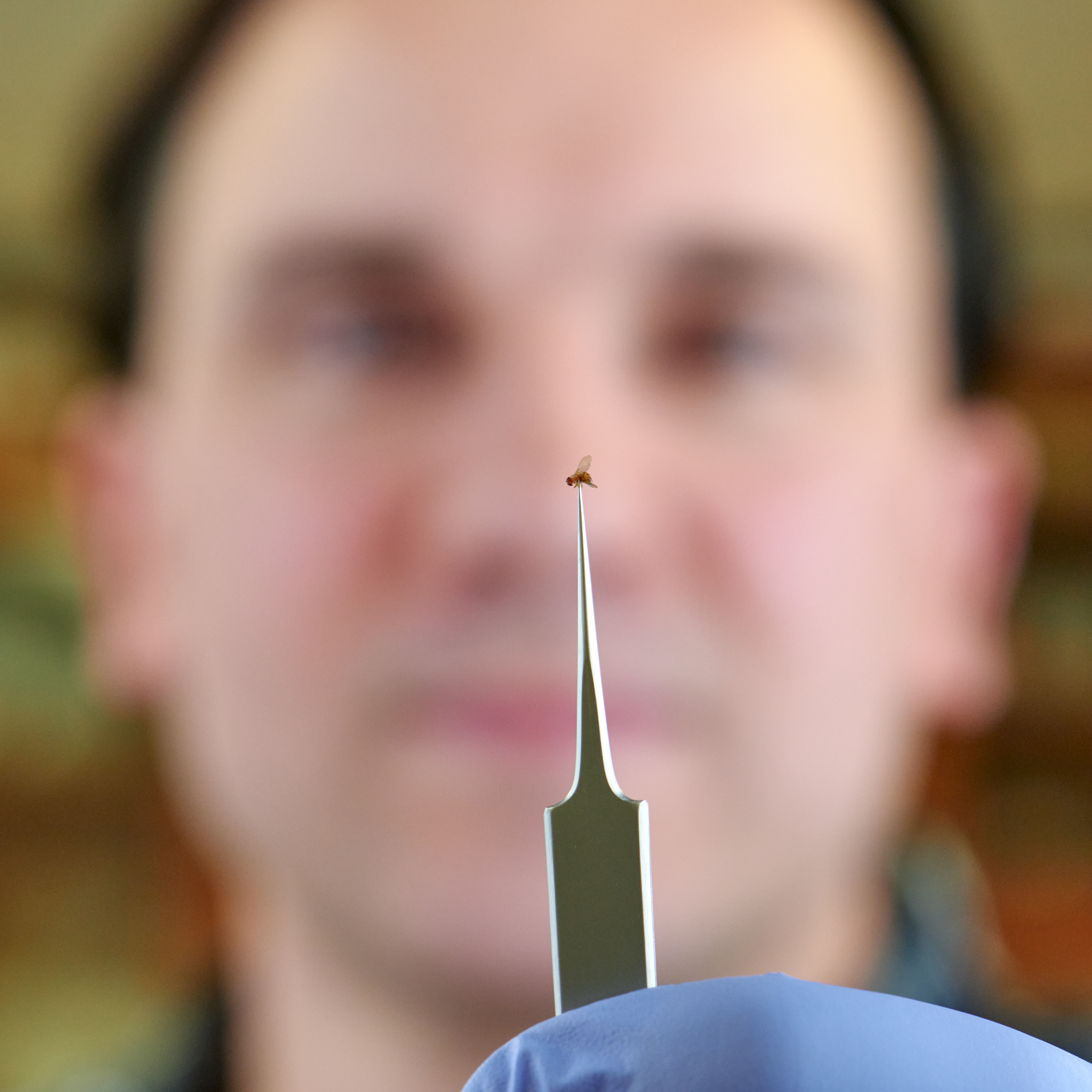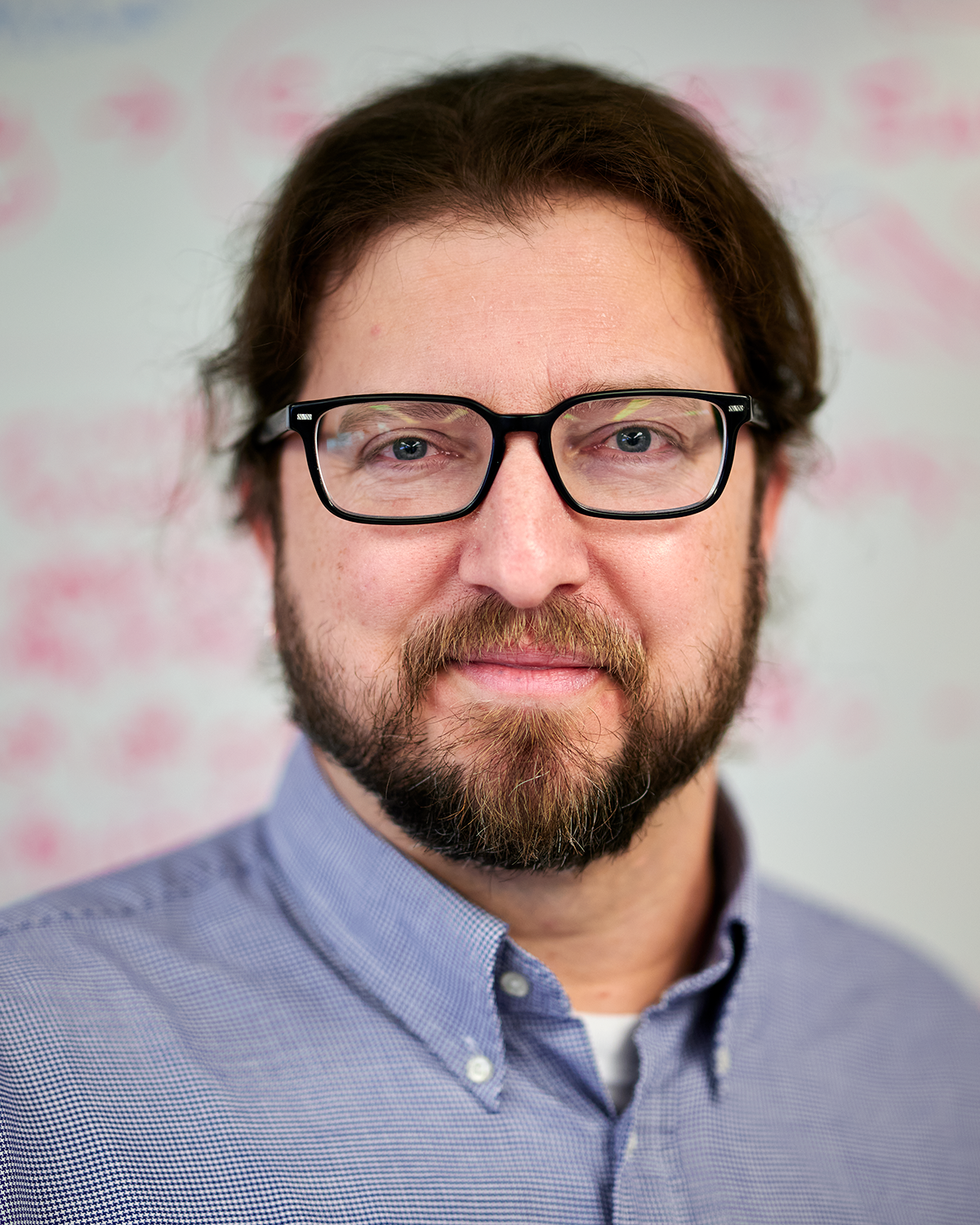 Feature
Feature
The Anatomy of a Fruit Fly (Class)
Two professors and a grad student devise a class to help students get the wet lab experience they need for grad school – with an assist from the mighty fruit fly. By Kim KriegerPhotos by Peter Morenus
The patient lies still on a white platform while the young surgeons glove up. Reaching for the scalpel, one of them hesitates.
“Remember that toothpaste motion we discussed!” says Kate Gavilanes ’22 (CLAS). Gavilanes has never attended medical school, but she has a wealth of surgical expertise.
“In non survival surgery,” clarifies physiology and neurobiology (PNB) professor Geoff Tanner, Gavilanes’ master’s degree supervisor and a fellow instructor. The two teach a class that focuses on that most basic of lab animals: the fruit fly. Open to any undergraduate, the course confers skills in fly husbandry, anatomy, genetics, metabolism, and all the assays, biochemistry, and statistics needed to do it. The purpose of this class is to bridge that chasm that every student encounters if they decide to do medical or biological research: to get a job in a lab or go to med school, you need experience. But you can’t get experience without a job in a lab.
Gavilanes and Tanner have an easy back and forth, with Tanner focusing on teaching the students scientific method and fly physiology, while Gavilanes instructs them on surgical and laboratory techniques. Jeff Divino, the third instructor in the course, acts as professional devil’s advocate.
“I try to identify with where our students are coming from,” PNB professor Divino says. What Divino, Gavilanes, and Tanner have in common, they also share with many of their students: none of them planned on a career in research. Gavilanes is a first-generation immigrant and college student. She lacked the contacts and experience young Americans with college-educated parents tend to take for granted. Divino goes so far as to describe himself as “clueless” in undergrad, and Tanner spent his 20s teaching school in Gujarat, India, living with a family in a palace, and developing a phobia of dogs.
The three created this class because it is the one they wish they had had as undergraduates. It fills a need that many students only realize late in their undergraduate careers. If you left college more than 15 years ago, it can be hard to understand how competitive medical and graduate school admissions have become – and how absolutely necessary lab experience is.
•

The Surgeon – Kate Gavilanes

The Method Master – Geoffrey Tanner

The Devil’s Advocate – Jeff Divino
The three instructors span this cultural divide: Tanner, who graduated from Yale in the 1990s, recalls how if you had good grades (or sometimes even if you didn’t), you could just write to professors whose work you admired, apply to graduate programs at their school, and reliably get in somewhere.
Divino graduated from Gordon College in Massachusetts in 2002 with a bachelor’s in biology. He liked fishing, so he applied for a graduate program in fish evolutionary ecology and received a master’s after multiple years of fieldwork, but no training in molecular analysis or genetics. Acutely aware of his lack of experience, he followed his wife to Iowa and took a job in a lab at her medical school. It was there that he finally learned basic biological molecular wet lab techniques, such as using a pipette to extract genetic material, a centrifuge to spin it, and a polymerase chain reaction to read the DNA. Despite his master’s degree, he considers the lab to have taken a chance on him. And finally learning those wet lab skills allowed him to pursue, and earn, a UConn Ph.D. in ecology and evolutionary biology in 2016.
Gavilanes was born in Ecuador and grew up in Stratford, Connecticut. Her plan was always to go to medical school. She took Tanner’s Enhanced Human Physiology & Anatomy class sophomore year, sitting in the front row both because she is hard of hearing and because it was at 8 a.m.
“Occasionally I would fall asleep. And inevitably, when I woke up we were making eye contact,” she recalls. It was embarrassing. (Tanner claims no memory of this: The class has 400 students, a certain percentage were always going to be asleep, he explains.) Gavilanes’ pre-med advisor told her she’d need to do research, and ideally shadow a doctor, to get into medical school. And then COVID hit in the middle of that year. Unable to shadow a doctor or meet professors in person, she logged onto the undergrad research website and saw Tanner had an opening. Four years later, she’s working on her master’s in his lab, teaching this undergraduate class, and still plans to go to medical school.
•
“The tiny insects continue to surprise with the immense insights they give”
“Just squeeze ’em out. Those ovaries should be nice and plump!” Gavilanes exhorts the students to be firm yet careful. Those forceps have tips just 3/100 of a millimeter thick but they are sharp, and will slice human skin as easily as insect carapace.
Some groups of students are excising ovaries while others have only just started sorting their fruit flies into groups of males and females. They use paintbrushes to gently pick up and move the flies. Quiet discussion between students sorting and dissecting can be heard, reminding each other to be careful. Flies are resilient, one student comments. Not when you’re squishing them with a plug, another retorts.
Many of the students are exactly the demographic the researchers hoped to get into the class. Michael Degloria ’24 (CLAS) is a PNB senior who wants to go to medical school and has never worked in a lab before. When it comes to bench research, “I always thought I don’t want to do that, it’s boring,” he says. But not this class. He’s actually considered going into research now. Another PNB student, Sravani Prekki ’24 (CLAS), is currently applying to graduate school for neuroscience and had no wet lab research experience before this.
“I’ve always been interested in unknowns,” Prekki says.
Down the hallway from this lab is one that studies ovulation in fruit flies and new avenues for birth control. Just beyond is Tanner’s lab, which uses flies to study how diet can ameliorate traumatic brain injury. Other researchers in the building study how molecular mechanisms control the size of organs and tumors in fruit flies, or how genetic differences between flies can influence how a fly responds to different odors. Across the University, fruit flies are used to study aging and Parkinson’s disease; how diet can influence longevity; metabolic disorders; RNA splicing and protein functions; how DNA folds into chromosomes; how genes are silenced; and why for stem cells, location is destiny. And this list is by no means exhaustive.


Students, such as senior Michael Degloria, study fruit flies in this class to determine whether diet can help animals recover from concussions.
Tanner and Divino cultivate relationships with researchers across UConn who are willing to take undergraduates into their labs. Many, but not all, use fruit flies in their research. But they don’t have to – the skills translate. And that’s half the point.
The other half is to get students to enjoy research. The process is part of the pleasure. And it seems the professors are successful.
“I love my lab group. It’s fun and lighthearted,” says Falyne Driver ’23 (CLAS). “Working in a lab can be stressful,” continues the December grad, noting that even though this class does real research on traumatic brain injury in flies, the professors are very understanding when it comes to data. “They understand that what you get is what you get,” she says.
One lab bench over sits a wooden contraption with a large spring attached. It has a certain degree of violent, Looney Tunes whimsy about it. Divino made it so the students could give the flies concussions with a known amount of force. Divino makes, modifies, or borrows much of the lab’s equipment, and his skill at stretching the class’s slim budget is much appreciated, as is his good humor when instructing others how to use the equipment.
This playfulness does not mean the class lacks rigor. After taking a break from ovary extraction, the class is back at the blackboard, and Tanner is lecturing them on data analysis. Divino interrupts. Doesn’t averaging the data points to make the initial calculation easier mess up the analysis later on? “Asking for a friend,” he jokes. Tanner does a quick calculation on the blackboard to show his method gets the same result and is mathematically equivalent either way. Divino says he has to make a phone call and dashes out of the room.
Five minutes later, he’s back, hauling a statistics tome. He quotes a paragraph to Tanner explaining that the averaging technique is no good. And then a student pipes up who has been hitherto silent.
“The R-values are different. I just ran it in the computer,” she says.
“Ha!” Divino says exultantly.
Tanner admits he stands corrected. Then he asks if anyone else has any questions. And then another student, previously quiet, asks a question. And then a follow-up.
Tanner asks if it’s clear. No, the same student replies, and asks another question. And another. And another. Everyone listens, and weighs his words, and Tanner diligently explains, and you realize that this is true pedagogy and research in action. Everyone has equal rights to question, to answer, to work out truth empirically.
“It’s supposed to be veridically scientific experience. Here, we don’t know the expected outcome,” Tanner says. And that’s true for their fruit fly research. The tiny insects continue to surprise with the immense insights they give. So, too, do the students, who surprise themselves with what they can learn and do. Even the professors learn new things, because this class is not like a cake recipe that comes out the same every time. This class teaches the scientific method, a way to look at the world and find truth. And whether a student ends up going to medical school or becoming a biological researcher or doing something else entirely, that student will always have this method and these skills, thanks to their semester working with the fruit fly.
Why the Fruit Fly?
Ever since Thomas Hunt Morgan discovered sex-linked inheritance and genetic recombination using fruit flies raised in milk bottles, Drosophila melanogaster has been the model lab animal of choice. Here are just a few of the many reasons:
- Fruit flies are easy and cheap to raise.
- They have a short life cycle of only 60-120 days.
- Fruit flies grow from egg to adult in 14 days or less and lay large numbers of eggs, making it easy to study genetics and behavior over multiple generations.
- However, if you need to delay your experiments for some reason, you can lower the temperature and the flies may take up to twice as long to mature.
- Female fruit flies lay as many as 100 eggs a day, making them useful models for studies of reproduction.
- Fruit flies have only four pairs of chromosomes, which made it relatively easy to analyze their genes in the early days of genetics.
- Despite the small size of their genome, fruit flies share many important genes with mice and humans. About 60% of all human genes, and 75% of the disease-causing genes, have equivalents in fruit flies. This is even reflected in their names. For example, the important gene “Notch,” which controls cell differentiation in humans (and mice and flies), is named for the notched pattern that a mutation of the gene causes on fly wings.
It may seem impossible to work on something barely 3 mm long, much less on the smallest part of something this small, but all you need are the right tools – and a steady hand.
